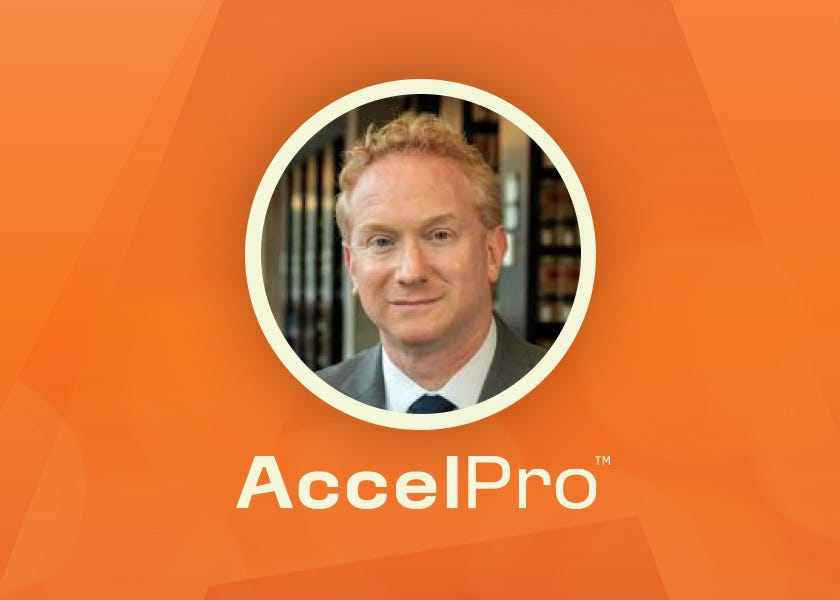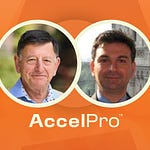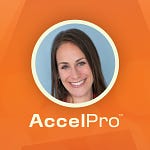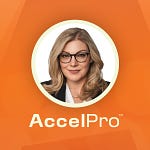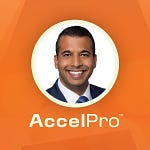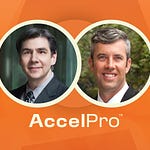RSVP now for next week’s virtual event: Where Employment Law and Entertainment Collide. Join us and employment lawyer Joe Beachboard on April 25th at 12pm ET. Reserve your spot now.
Listen on Apple Podcasts, Spotify and YouTube
Welcome to AccelPro IP Law, where we provide expert interviews and coaching to accelerate your professional development. Today, we are featuring a discussion with Jonathan Masur about real world prior art.
Masur, a professor at the University of Chicago Law School, specializes in patent law, administrative law, behavioral law and economics and criminal law. In this conversation, we talk about whether an invention is or is not novel, litigation over these issues and more.
“It’s an interesting subject to talk about because the rules for real world prior art in the physical universe are different from the rules for prior art on paper,” Masur says. “They are more complex in a lot of ways and the courts are still trying to work them out in ways that they are not when it comes to paper prior art.”
Listen on Apple Podcasts, Spotify and YouTube.
Interview References:
Jonathan Masur’s University of Chicago Law School profile.
2:50 | Masur, Jonathan S. and Larrimore Ouellette, Lisa. Real-World Prior Art. (January 27, 2023). Stanford Law Review, Vol. 76 (forthcoming 2024), University of Chicago Coase-Sandor Institute for Law & Economics Research Paper No. 973, U of Chicago, Public Law Working Paper No. 821.
12:38 | Masur, Jonathan S. and Larrimore Ouellette, Lisa. Patent Law: Cases, Problems, and Materials. (2023).
15:53 | Masur, Jonathan. Patent Inflation. (December 2011). 121 Yale Law Journal 470.
16:23 | Larrimore Ouellette, Lisa. What Are the Sources of Patent Inflation? An Analysis of Federal Circuit Patentability Rulings. (December 2011). 121 Yale Law Journal, Online 347.
TRANSCRIPT
I. WHAT IS “REAL WORLD PRIOR ART?”
Neal Ungerleider, Host: What is “real world prior art” and why is it so important for determining the novelty of an invention?
Jonathan Masur: This is just our term of art for public use and on sale prior art. We call it that because that's prior art based on real world instantiations of the invention, and that's contrasted with what we call paper prior art, which is basically printed publications and patents–the invention written down on a piece of paper.
We think, first of all, this is a sort of coherent category of things. It’s an interesting subject to talk about because the rules for real world prior art in the physical universe are different from the rules for prior art on paper. They are more complex in a lot of ways and the courts are still trying to work them out in a lot of ways that they are not when it comes to paper prior art.
There are a lot of invalidations at this point that are taking place based on real world prior art. Public use and on sale prior art is a big important category with many cases, especially in federal District Court, being decided on those grounds. So it is important that the courts get this right and that lawyers know what the rules are.
NU: How did the idea for the paper on real world prior art come about? Were there any particular cases in your mind?
JM: My Co-author, Lisa Ouellette, and I sat down to write a whole patent case book. We both teach patent law and we were not 100% satisfied with the options we had for books to teach from. So we said “Let's just write our own book.” At minimum we can use it ourselves to teach our own classes–that would be reward enough if we get to do that.
When you sit down and write a book like that, you must figure out every nook and cranny of the law to a pretty fine-grained level of particularity. You can't wave your hands at anything. You've got to put it on a page so that you understand it, your students can understand it, and you can explain it to someone else.
As we were writing the book, we realized that we didn't feel like we fully understood the rules for real world prior art. We decided to dig into that a little bit more because we felt like we had to understand them extremely well, or the book was not going to work.
At a certain point, we realized the reason we don't understand these things perfectly is because the rules are incoherent. They're internally inconsistent. There are multiple competing lines of precedent. Our confusion was being driven to a degree by the court's confusion. That was the genesis for this article.
NU: Does the public demonstration of an invention without physical interaction affect its status as prior art?
JM: This is one of the big questions that we talk about. We call this public use without the public using. Imagine that you've got an inventor who is demonstrating an invention at a trade show. You've got the public watching the demonstration happening, but they're not actually touching the invention.
Is that prior art that would then bar someone else from getting a patent? There is one strand of precedent that would say, “No, that can't be prior art because the public is not making use of the invention. So, it's not public use.”
There's another strand of argument that says, “That is prior art because even though the public isn't using it, it's being used in public.”
There’s a third strand of precedent that says, “That is prior art, but it's only prior art if the demonstration is enabling.”
In other words, it's only prior art if a member of the public who's watching the demonstration would then know how to make and use the invention on their own.
One thing we do is try to sort through these three potential answers, and the answer we come up with is that the third one is correct–that this should be considered prior art, but only to the extent that people in the public could make and use the invention after the demonstration. Only to the extent the demonstration is enabling.
NU: Does the ability to reverse engineer an invention based on demonstration impact its legal novelty?
JM: It doesn't necessarily impact the novelty of that particular invention if the person who demonstrates it is trying to patent it. If you give a public demonstration like this in a way that makes the invention potentially reverse engineer-able, well, what that means is that you have conveyed the information about that invention to the world. You've told the world the details that they would need to know to make and use that invention. We should think of that as equivalent to writing it down on a piece of paper. It's like a printed publication in the sense that you are telling the world the relevant information–it's just not printed.
It could be thought of as a videotaped presentation or a presentation that's made to an audience without any recording taking place. In those cases, that invention is now not novel for anyone else. You've given it to the world. No one else in the world gets to patent it just like as if it were a printed publication.
—
II. PUBLIC USE QUESTIONS
NU: What is the difference between “public use” and “on sale” in the context of real world prior art?
JM: This is one of the important things that we spend a lot of time on in our article. Public use and on sale get run together a lot and you hear the courts sort of put them together as public use and on sale as if it were a single category.
These are really two categories of prior art that have two very different rationales and policies behind them. Public use is about making sure that you don't deprive the public of an invention that they think is in the public domain and have come to rely on. The on sale bar is primarily about making sure that someone doesn't have monopoly rights over an invention and exploit those monopoly rights for more than the 20 years that they're entitled to.
I'm simplifying these things a little. Those provisions are about more than just that, but those are the main points. What that means is that there are certain circumstances in which the on sale bar is implicated, but the public use bar is not, and conceivably vice-versa.
I gave you an example where public use is implicated earlier, but on sale is not. I'll give you an example the other way around. Imagine that I create an invention and sell it to you, but I tell you to keep it secret, share it with nobody else, and divulge it under no other circumstances.
Or maybe I put it on sale, but nobody buys it. It is black letter law that when I make that sale to you, or put it on sale, that invention is now on sale prior art because I've tried to exploit my right to it, and earn monopoly pricing from it outside of my 20-year term.
That invention is on sale, but it's not really in public use because the public hasn't come to rely on it in any way. The public doesn't believe that it has access to that invention. Either nobody bought it or you bought it, but I made you promise to keep it secret.
What does that mean? It means that I shouldn't be allowed to get a patent going forward because I tried to exploit my right to that invention for longer than I'm allowed to.
It doesn't necessarily mean that no one should be able to get a right to that patent. The patent hasn't come to the public, unlike the demonstration we were talking about a second ago. Instead, I'm keeping it secret. I'm sort of holding it as a trade secret, maybe with you, my customer.
If somebody else comes along and actually invents it in a public way and tries to patent it, they've done something valuable that I didn't. They tried to bring it to the public. That’s why we say that's a situation that should trigger the on-sale bar, but only to the person making the sale and not to the rest of the world.
NU: What are the conditions under which a party would forfeit the opportunity to obtain a patent?
JM: The idea is that you would forfeit the opportunity to obtain a patent if you were the one who put something on sale and then didn't file within the necessary year after that.
But if a third party put it on sale, and I see something appear on Amazon, let's say, but no copies of it are ever sold or somebody makes a secret sale where the customer promises they have to keep it secret… Under those circumstances, a third party can still get a patent.
Part of what we're trying to argue in this article, both as a matter of what we think is sound patent policy and as a matter of what we think actual governing law is, is that the on sale bar should be party-specific. It should only bar the people who've actually made the sales.
The public use bar should be universal if something enters public use that should bar everyone from getting a patent. And that difference between public use and on sale we think is critical to the law.
NU: How have courts and the patent office interpreted real world prior art?
JM: They have been a little bit all over the place with this. We catalog in our paper all of the instances in which the Federal Circuit has considered a case that involved a sale made by one party and then an attempt by a third party to get a patent on the same invention.
There are about eight such cases. In one of them, the court said that even though that sale was secret, the on-sale bar still bars everyone.
In another one, the court said that because that sale was secret, the on-sale bar is party specific and only bars the party making the sale.
In the other six, the court has sort of said that everyone is barred, but those other six cases involve situations where the sale was not a secret or private sale. Rather, it was a public sale that put the invention into public use at the same time.
Public use should generate a universal bar. Here, we see the Federal Circuit really trying to struggle through these issues and being of two minds about it. Depending on which case you happen to look up first, you might get a very different perspective on the law.
This is a tricky area of law. I certainly don't fault the court for trying to work through it. What we want to say is that there's law going in both directions. In the paper, we spend a little bit of time looking at what the lower courts have done, and how they're also all over the map.
Federal District Courts around the country sometimes will decide that the on-sale bar is party specific. Sometimes they will decide that the on-sale bar is universal. It just depends on which case they happen to pull up and what they're looking at. So we're trying to bring a little bit of coherence to this area of law.
NU: What are the most interesting things you came across while you were writing the paper?
JM: I think the most interesting thing we found was this line of cases about public use without the public using.
What was so interesting about it was that there were a whole series of cases that seemed to be saying that public use happens when a member of the public who doesn't have any duty of confidentiality to the inventor gets to use the invention.
There are a lot of cases going into the details of that, but that seemed to be the fundamental idea. A member of the public who has no duty of confidentiality to the inventor uses the invention and then we find these other cases go almost unmentioned amongst that long line of precedent that date back to a Supreme Court case from a hundred years ago that starts it off–then there's roughly radio silence for about 80 years or 100 years in the Federal Circuit.
Then you start to see a few Federal Circuit cases that pick up on this and say it can still be public use, even if the public never gets to use or touch the invention, so long as the public can understand how the invention works. As long as the use is enabling.
It was really interesting to see a completely separate line of precedent that seems to violate the number one rule of the doctrine of public use, that is of relatively recent vintage in the Federal Circuit.
NU: Can you tell our listeners about the paper you co-wrote and your book.
JM: Sure. The paper that we wrote is called Real World Prior Art and my Co-author is Professor Lisa Ouellette, who is a Professor of Law at Stanford Law School. Our paper, The Real World Prior Art, is available on SSRN right now and it will be in the Stanford Law Review.
The book that we wrote is called Patent Law, Cases, Problems, and Materials.
It's a case book meant to be used in a basic patent law course, although my co-author Lisa also uses it in her Introduction to Intellectual Property course. We also know people who are using it in survey courses.
The book is completely free. You can download a PDF of the entire book for free on our website, Patentbook.org., and you can buy a physical copy on Amazon at cost.
We make zero dollars and zero cents from it, and we think it's a pretty good resource for patent practitioners.
We sent it to a lot of law clerks who go off to clerk for judges on the Federal Circuit or district courts. It's now in use at about 60 law schools, so we are really pleased that other teachers out there have found it useful teaching material. We think of it as a pretty good resource that is available at a reasonable price.
—
III. CAREER PATHWAYS
NU: You majored in physics and political science at Stanford. Can you tell the AccelPro community how that's helped your career?
JM: One thing that a lot of people in your community can probably relate to is that if you have a STEM degree and you're in law school, the intellectual property world will find you. When I first–as a 1L– started applying for jobs, it was quickly the case that the firms that were most interested in hiring me were firms doing IP work.
They saw that physics degree on my resume and thought, “Here's someone who could be a good IP attorney for us.” I was doing patent work at a little boutique firm the summer after my 1L year. I was exposed and became interested in it very quickly. That was the case even as my career progressed.
I went and clerked for Chief Judge Marilyn Hall Patel in the Northern District of California, which is obviously a very patent heavy jurisdiction. I think that Judge Patel was probably happy to hire me, in part because she felt like I would be decent at handling the patent cases that court had.
I then went into a second clerkship with Judge Richard Posner on the Seventh Circuit. The Seventh Circuit doesn't take any patent cases, but Judge Posner loved patent cases and was fascinated by them, so he would sit by designation on the Northern District of Illinois and take patent cases just as a little bit of extra work on the side.
We actually had three or four patent cases that year that I was clerking for him in a court that ostensibly doesn't do patent work.
I think that at this point–as your listeners are well aware–the number of patent cases that involve the type of physics that I was doing as an undergraduate are pretty small. There are a lot of semiconductor cases that are a little bit related to physics and there’s an enormous amount of biotech.
I think that the IP community thinks–in my case, correctly–that you are not going to be afraid of science and that you're willing to dive in with both feet.
I'm not afraid to open up a patent on biotech–even a subject I don't know much about–and because I feel like I can try to learn it the way I've learned a lot of other science, that has been useful. Simply having these sorts of opportunities to continue working on patent cases in a lot of different venues has been really valuable as well.
NU: Can you give an example of a time that a peer helped you with a challenging moment in your career?
JM: I actually have a very on-topic example that springs immediately to mind.
When I was in my fourth year as a law professor, I published an article in the Yale Law Journal. This is one of the most prestigious journals that law professors can publish in, and this was a really big deal for me at the time.
I was not tenured, so I was getting ready to go up for tenure and worried about what my prospects would be. This was an article that I was really very proud of, and I was really excited that I got it published in this prestigious journal.
After the article was published, one of the group of people who had selected the article for publication decided to write a response to it that was published also by the Yale Law Journal in their online supplement.
The response was a very direct attack on my article and argued that the phenomenon that I was trying to describe actually didn't exist for reasons that I hadn't figured out and it was due to something else.
I thought to myself that here's this kind of crowning moment in my nascent career, and one of the people who accepted my article is trying to take it away from me. My first reaction was shock and displeasure. I went back and I read this online piece again pretty carefully.
I thought to myself “I don't agree with this.” I think that my article is still correct. I don't agree that this author has it right, but this author seems very smart and is making a lot of good points, especially for someone who's very early on in their career as well.
I thought we should talk this through. Maybe I can get some suggestions for how to improve my work and we could talk things through and maybe we have something to collaborate about. I asked if they'd be willing to chat on the phone, and they said yes.
I called the person up instead of fighting about this. I am not going to try to be combative. Let's just talk through these ideas and see if we have common ground. At the end of the phone call, the two of us had agreed to write a paper together.
That editor who wrote that critique of my piece was Lisa Ouellette, my co-author on this paper. She and I, since that moment, have written this book together, and now we've written one article that we've been talking about, and another article that's in draft.
She's one of my most valuable collaborators and has been an incredible resource, co-author and colleague in the academy for more than a decade now. It all started at this sort of low moment when I thought that she was coming after me in my article, but it turned out that she was actually just being a great colleague in offering valuable and substantive critiques and sharing her ideas with me and with the world.
One of my most valuable professional relationships came out of this dark moment when I thought that my magnum opus was being attacked by the same journal that had published it.
Listen on Apple Podcasts, Spotify and YouTube.
This AccelPro audio transcript has been edited and organized for clarity. This interview was recorded on March 6, 2024.
AccelPro’s expert interviews and coaching accelerate your professional development. Our mission is to improve your day-to-day job performance and make your career goals achievable.
Please send your comments and career questions to questions@joinaccelpro.com. You can also call us at 614-642-2235.
If your colleagues in any sector of the IP law field might be interested, please let them know about AccelPro. As our community grows, it grows more useful for its members.




